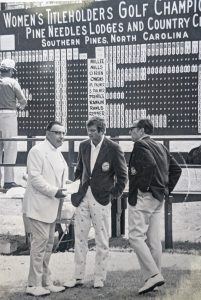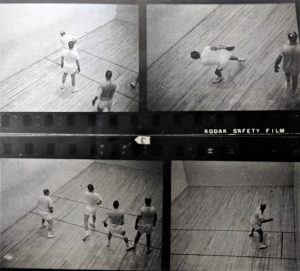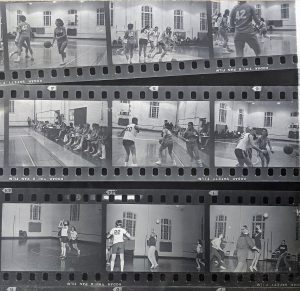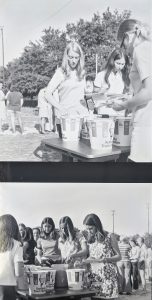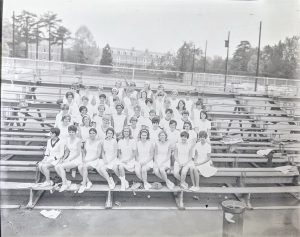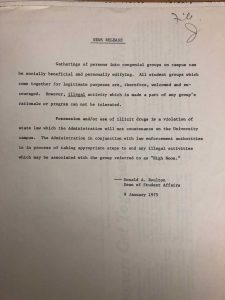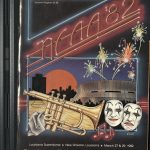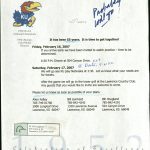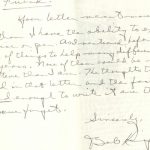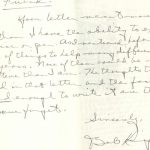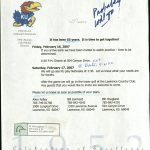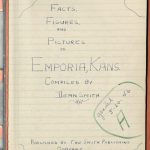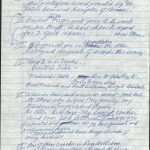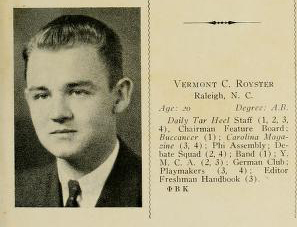The University of North Carolina at Chapel Hill was founded in the midst of a slave society by slaveholders. Enslaved people were present on campus from the laying of the cornerstone of Old East in 1793 until the end of the Civil War in 1865. Enslaved people built the earliest structures on the campus, many of which still exist. Old East, Old West, Gerrard Hall, South Building, Steward’s Hall, Person Hall, Smith Hall, and the original President’s House all took shape under the skilled hands of enslaved people owned or hired by the University’s trustees, employees, students, architects, and the townspeople of Chapel Hill. Enslaved people made repairs, provided supplies, and attended upon students and faculty as servants. This post is part of a series looking more closely at records documenting slavery at UNC. Explore all of the posts here.
The joint efforts of researchers, archivists, historians, students, and administrators has resulted in the identification of more than 100 enslaved people who built and labored at the University from 1795 to 1865. Students in History 398, an undergraduate seminar on slavery taught by Professor Jim Leloudis in Fall 2017 contributed significantly to this research. The list of 119 names enumerated below is neither exhaustive nor complete, and it is certain that countless enslaved people who built, worked at, and contributed to the University will never be identified. Enslaved women and children are likewise largely absent from this list, but it is hoped that future work will uncover more information about their presence at and contributions to the University. While we only have brief glimpses into the personal lives of the enslaved people who built and sustained the University, their places within the broader contexts of the University and the Chapel Hill community allows for some understanding of their experiences, and most importantly, their humanity.
Note: Some names are repeated several times or have slightly different spellings, and may indicate multiple mentions of the same person; however, in a number of instances, men with the same name had different owners, and so the names are kept separate for the sake of accuracy and clarity. Additionally, there are several sources that mention unnamed enslaved peoples’ work, which have been omitted here for clarity. We are in the process of preparing, and will soon share, a spreadsheet with full citations to the records that mention the people listed below.
| Name | Occupations and Labor on Campus |
| “John Hoggs man” or John Hoggsman | Labor on belfry and cupola in South Building; putting roof and portico in Gerrard Hall in 1826 |
| [Mason’s] Tony | Sawyer; repairs to Old East about 1823 |
| Abel | College servant hire in 1830 |
| Abraham | Repairs to South Building in 1837 |
| Adams | Labor on Old West in 1823 |
| Albert | Plasterer on additions to Old West in 1846; Brother of plasterer Osborne |
| Aldeman | Building Gerrard Hall in 1826 |
| Allaman | Labor on Old West in 1823 |
| Allan | Labor on Old West in 1823 |
| Allan | Labor on Old East in 1824 |
| Allman | Repairs to Old East foundation, taking down old gable, cleaning bricks about 1823 |
| Anderson or Andson | Sawing work on Old East and Old West in 1823 |
| Austin | Labor on unspecified buildings 1825-1826 |
| Ben | Servant hire at President’s House, 1850 |
| Ben | Laborer on repairs to South Building in 1837 |
| Benny | Labor on observatory, digging pits in 1832 |
| Bill | Carpenter labor on Old West in 1823 |
| Bob | Labor on observatory, digging pits in 1832 |
| Bob | Labor on Old West in 1823 |
| Bob | Bricklayer on Old West in 1823 |
| Bob | Repairs on Old East about 1823 |
| Cad | Labor on Old West and Old East in 1824; May have run away from the university in 1825 |
| Calvin | Plasterer and mason, repairs on South Building in 1837 |
| Caplen | Labor on Old East about 1823 |
| Ceaser | Labor on Old West in 1823 |
| Charles | Construction of Old West in 1823 |
| Charles | Labor on Old West in 1823 |
| Chester | Plasterer and mason, repairs on South Building in 1837 |
| Cicero | Plasterer and mason, repairs on South Building in 1837 |
| Clayton | Quarrying rock, making brick, repairs for the President’s House, Steward’s Hall, Gerrard Hall, South Building, and Belfry in 1826 |
| Clayton | Building Gerrard Hall, known as the New Chapel, in 1826 |
| Clinton | Labor on Old West in 1824 |
| Clinton | Labor on Old West and Old East in 1824 |
| Clinton | Plasterer and mason, repairs on South Building in 1837 |
| Daniel | Hired by William Nichols for unspecified labor in 1822 |
| Daniel | Quarrying rock, making brick, carpenter on repairs for the President’s House, Steward’s Hall, Gerrard Hall, South Building, and Belfry in 1823-1824, 1826 |
| Dave | Labor on belfry and cupola in South Building; putting roof and portico in Gerrard Hall in 1826 |
| David Barham | College servant hired from William Barham by Professor James Phillips in 1830 |
| Davy | Construction of Old West in 1823 |
| Dick | Brick work on Old West 1823-1824 |
| Dick | Building Gerrard Hall, known as the New Chapel, in 1826 |
| Edmund | College servant; Improvement of grounds in 1848 |
| Emmeline | Washerwoman, seamstress for students in 1846 |
| Ephraim | Laborer on repairs to South Building in 1837 |
| Evans | Plasterer and mason, repairs on South Building in 1837 |
| Frank | Apprentice to Harry on unspecified labor in 1826 |
| Gee | Plasterer and mason, repairs on South Building in 1837 |
| George | Unspecified labor in 1826, included on list of hires for work on the President’s House, Steward’s Hall, Gerrard Hall, South Building, and Belfry |
| Glasgow | Brickmaker on repairs to President’s House, Stewards Hall, Gerrard Hall, and South Building Belfry |
| Harry | Unspecified labor in 1826, had an apprentice named Frank |
| Harry | Building Gerrard Hall in 1826 |
| Harry | Building Gerrard Hall in 1826 |
| Henderson | Laborer on repairs to South Building in 1837 |
| Henry | Labor on Old West in 1823 |
| Henry | Repairs to Old East about 1823 |
| Henry | Labor on Old West in 1823 |
| Henry | Labor on Old West in 1823 |
| Henry Smith | College servant |
| Isaac | Labor on Old West and Old East in 1824 |
| Isaac | Construction of Old West, labor on Old East in 1823 |
| Isaac | Labor on belfry and cupola in South Building; putting roof and portico in Gerrard Hall in 1826 |
| Isom | Laborer on repairs to South Building in 1837 |
| Jack | Labor on Old West in 1823 |
| Jacob | Carpenter work on Old East and Old West, 1823-1824, 1826 |
| Jim | Construction of Old West 1823-1824, 1826 |
| Jim | Labor on Old West in 1823 |
| Joe | Construction of Old West 1823-1824, 1826 |
| John | Labor on Old West in 1823 |
| John | Sawyer on Old East, unspecified labor on Old West in 1823 |
| Jonathan | Waiting on masons “while at window sills” on Old East; assisting in hauling sand and rock about 1823 |
| Jorge | Laborer on repairs to South Building in 1837 |
| Jourdan | Master workman and carpenter, construction of Old West 1823-1824, 1826 |
| Jourdan | Laborer on repairs to South Building in 1837 |
| Lewis | Labor on Old West in 1823 |
| Lewis | Labor on belfry and cupola in South Building; putting roof and portico in Gerrard Hall in 1826 |
| Lewis | Laborer on repairs to South Building in 1837 |
| Luke | Labor on Old West and Old East 1823-1824 |
| Luke | Repairs on Old East about 1823 |
| Luke | Labor on belfry and cupola in South Building; putting roof and portico in Gerrard Hall in 1826 |
| Luke | Building Gerrard Hall in 1826 |
| Luke | Hired for unspecified labor in 1825 |
| Moses | Labor on Old West in 1823 |
| Ned | Labor on Old West in 1823 |
| Ned | Labor on Old East in 1824 |
| Ned | Building Gerrard Hall in 1826 |
| Ned Peek | Brickwork on Old West in 1823 |
| Nelson | College servant hired from Elizabeth King by Professor James Phillips in 1830 |
| Nelson | Repairs on Old East about 1823 |
| Nelson | Building Gerrard Hall in 1826 |
| November Caldwell | College servant in South Building and Old East for 30 years; wood collection |
| Osborne | Mortar work and plasterer on additions to Old West in 1845; brother of plasterer Albert |
| Peter | Repairs to Old East, President’s House, Stewards Hall, Gerrard Hall, and South Building Belfry in 1824 |
| Peter | Building Gerrard Hall in 1826 |
| Peter | Plasterer and mason, repairs on South Building in 1837 |
| Peter | Labor on Old West in 1823 |
| Peter | Labor on Old West in 1823 |
| Philip | Hired by William Nichols for unspecified labor in 1822 |
| Phillips | Carpenter work on Old East and Old West, 1823-1824, 1826 |
| Ransom | Labor on belfry and cupola in South Building; putting roof and portico in Gerrard Hall in 1826 |
| Redin[?] | Laborer on repairs to South Building in 1837 |
| Sam | Hired for unspecified labor in 1826 |
| Sam | Labor on Old West in 1823 |
| Sam | Carpenter on repairs to Old East, President’s House, Stewards Hall, Gerrard Hall, and South Building Belfry in 1824, 1826 |
| Sam | Labor on belfry and cupola in South Building; putting roof and portico in Gerrard Hall in 1826 |
| Sam Morphis | Hired himself out as a hack driver, dates unknown |
| Sim Fred | College servant; Improvement of grounds in 1848 |
| Stephen | Construction of Old West 1823-1824, 1826 |
| Sterling | Sawyer laboring on Old West, repairs to Old East in 1823 |
| Stewart | Plasterer and mason, repairs on South Building in 1837 |
| Thomas | Laborer on repairs to South Building in 1837 |
| Tom | Hired out at university for cutting wood in 1820 |
| Toney | Bricklayer laboring on Old East, Old West, Gerrard Hall, Steward’s Hall, and South Building belfry 1823-1824, 1826 |
| Will | Sawyer laboring on Old East, Old West, Gerrard Hall, Steward’s Hall, and South Building |
| Willis | Rock work for improvements to college grounds in 1848 |
| Willis | Labor on South Building and Gerrard Hall in 1826 |
| Wilson Caldwell | College servant |
| York | Construction of Old West 1823 |
| Young | Rock work for improvements to college grounds in 1848 |
| Zack | Hired for unspecified labor in 1826 |

